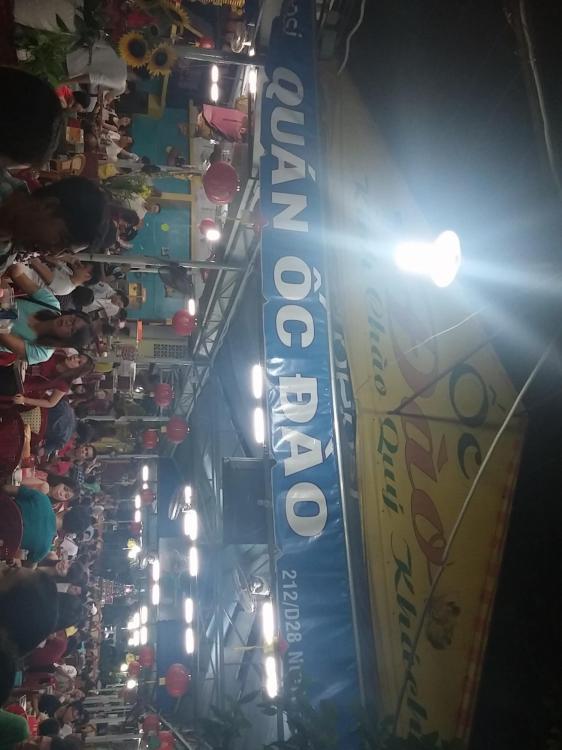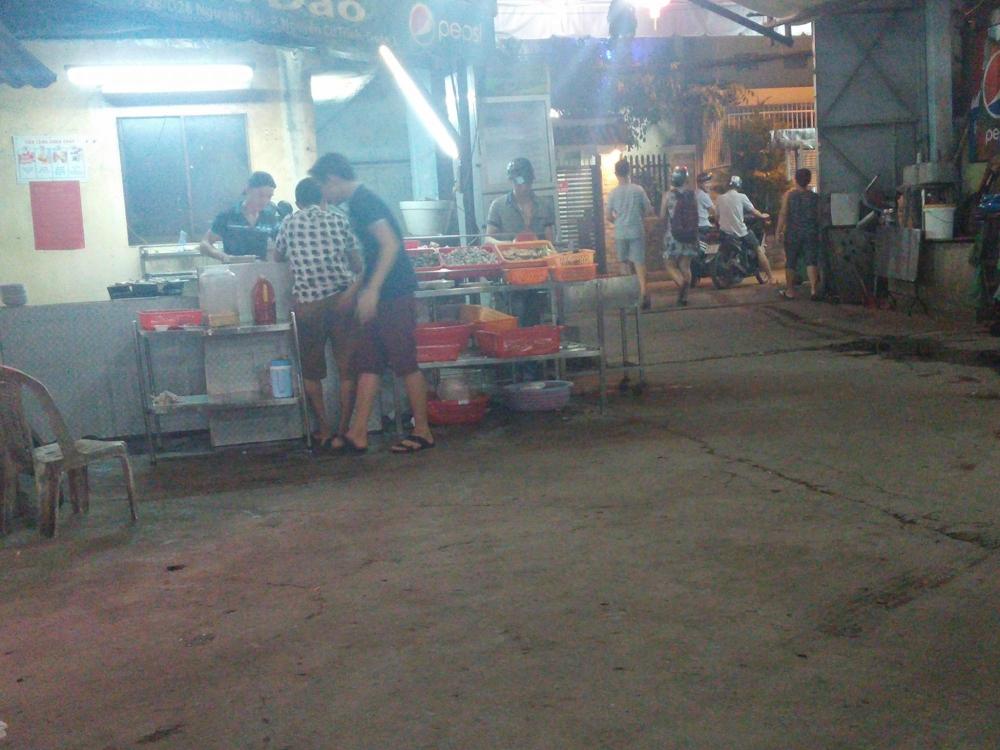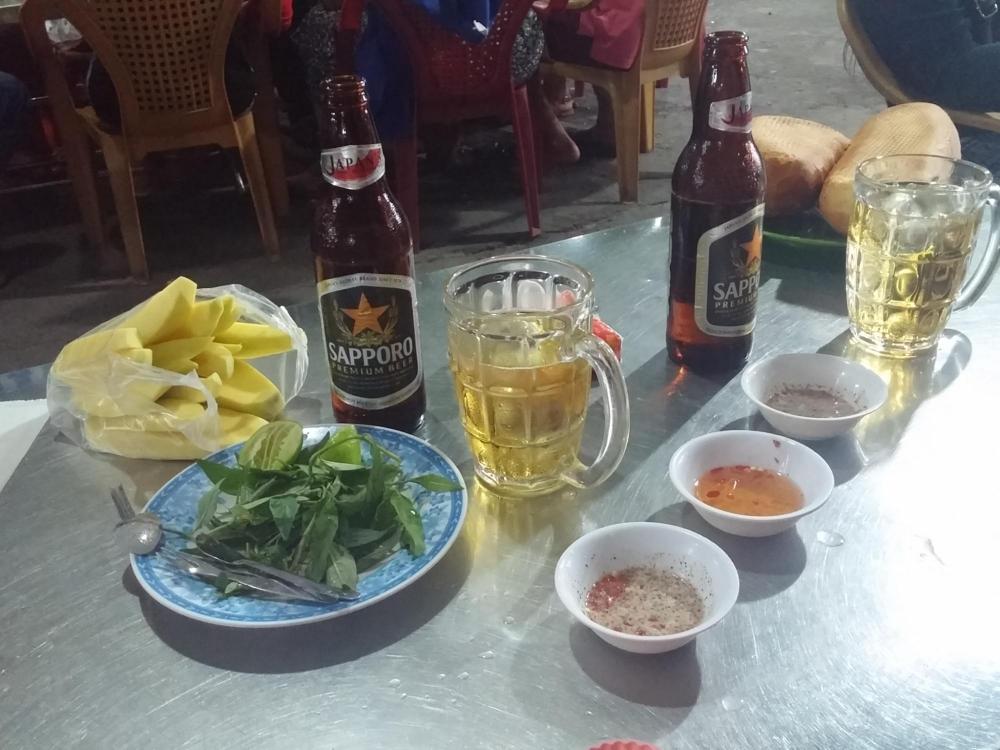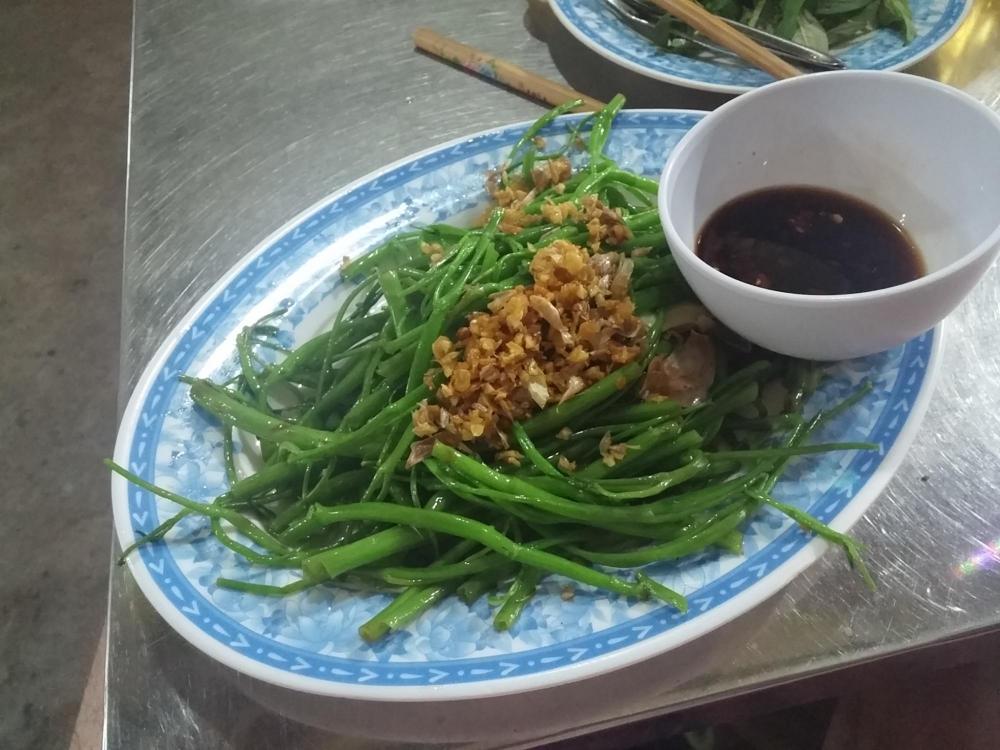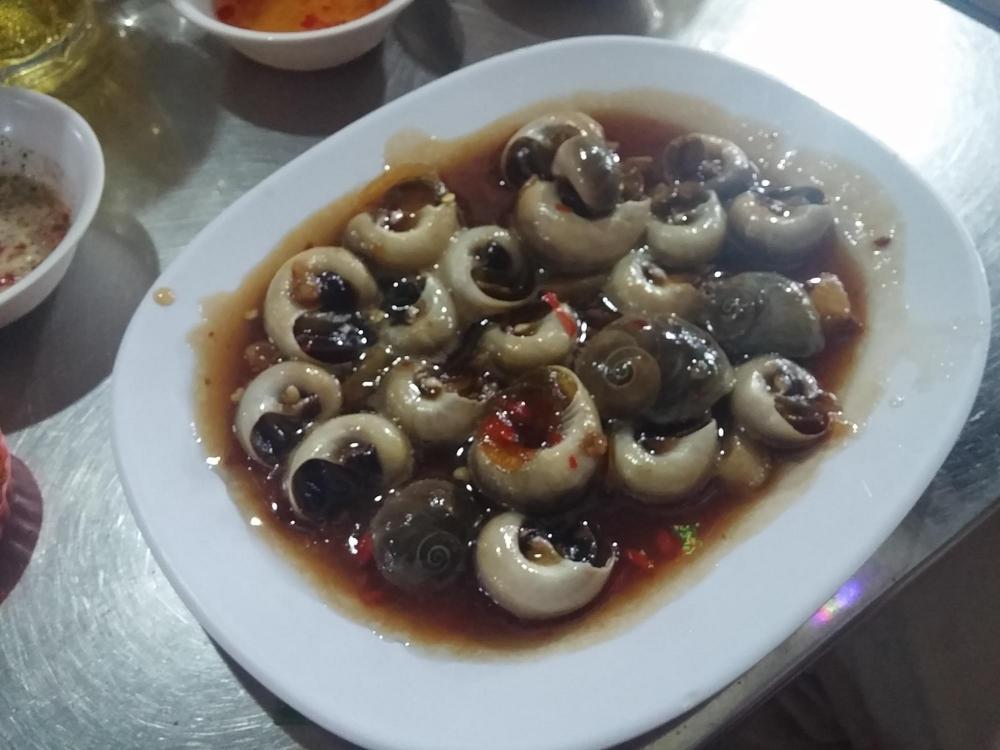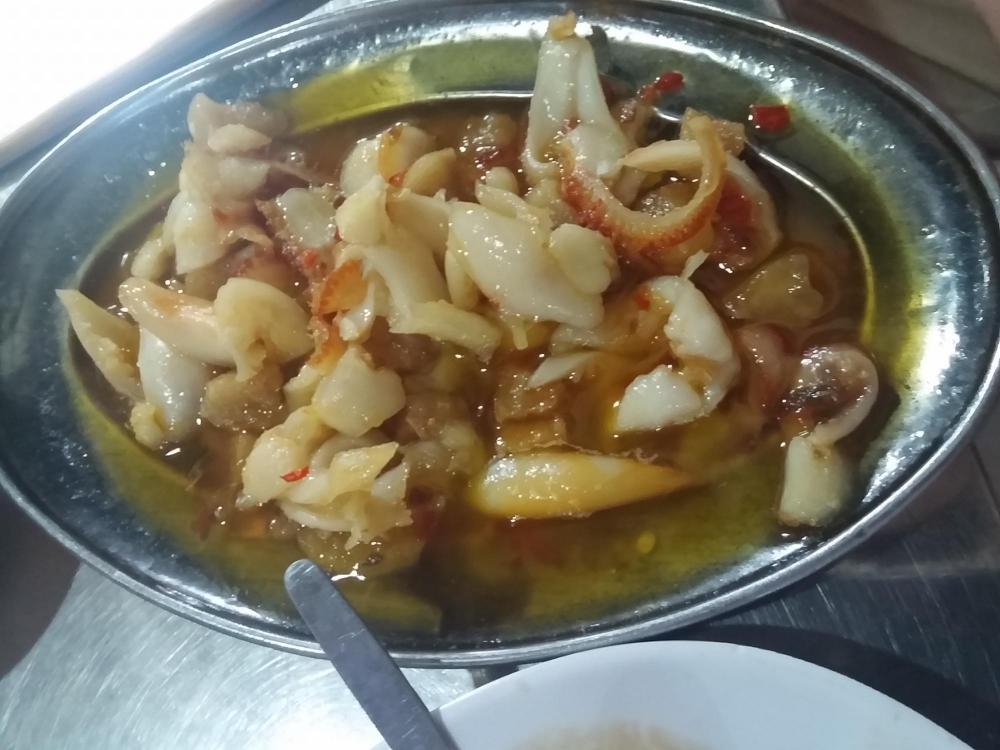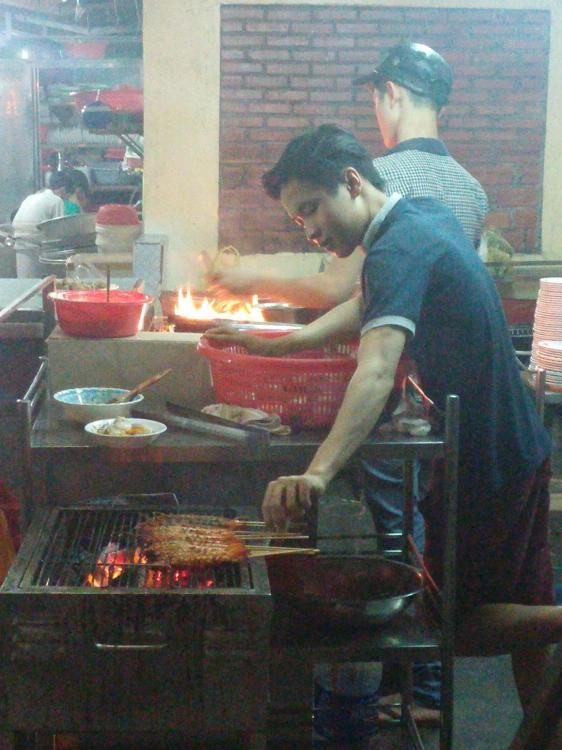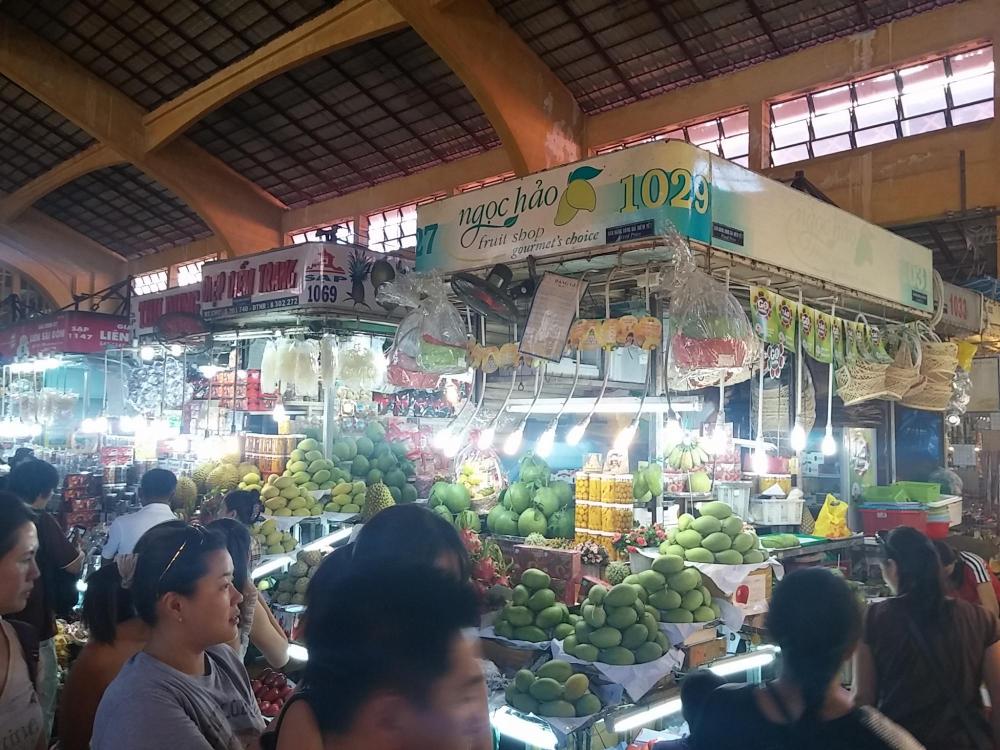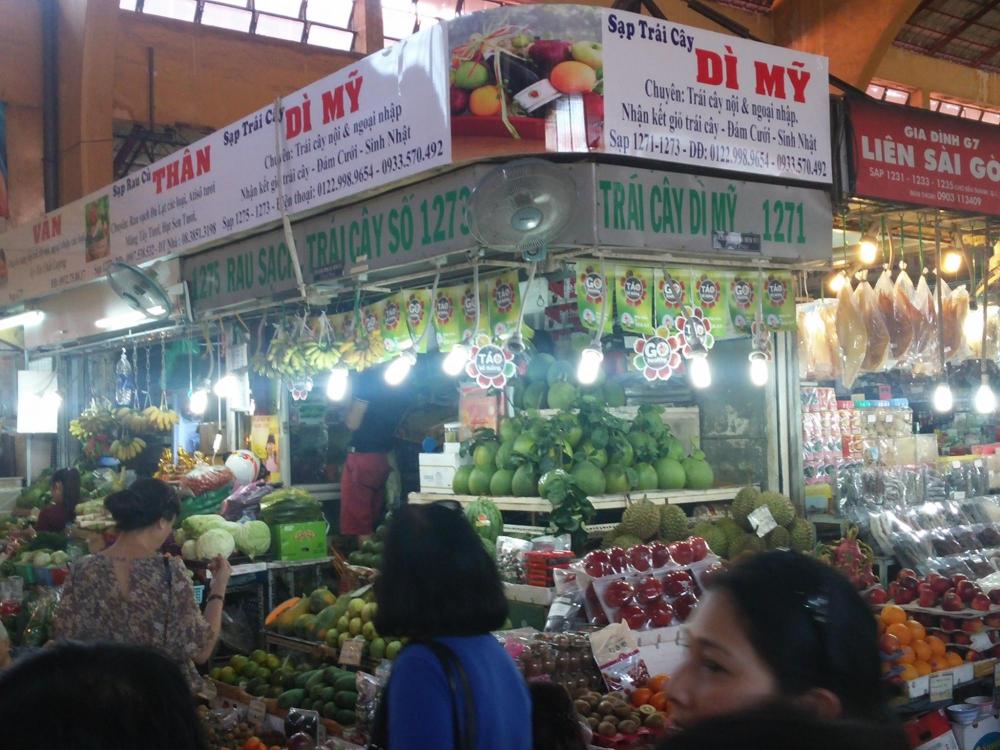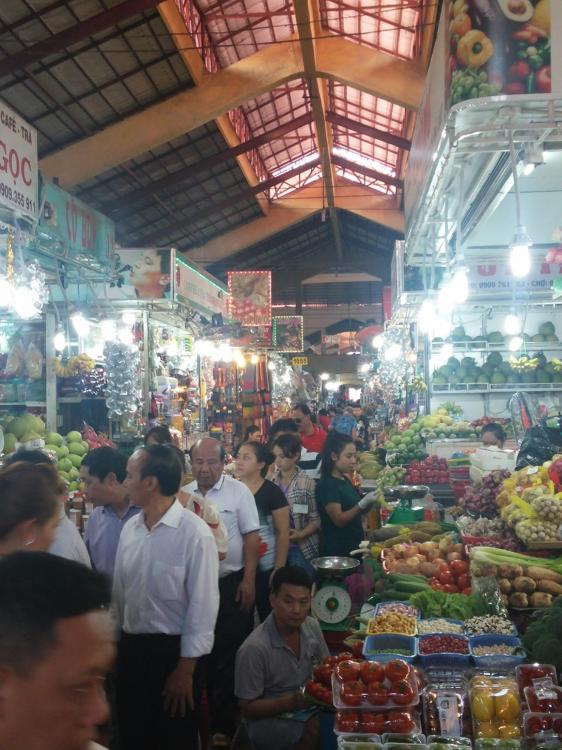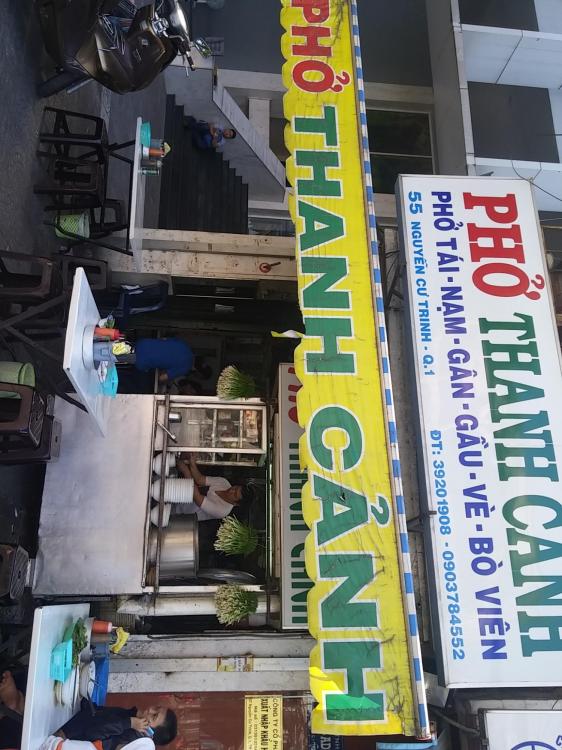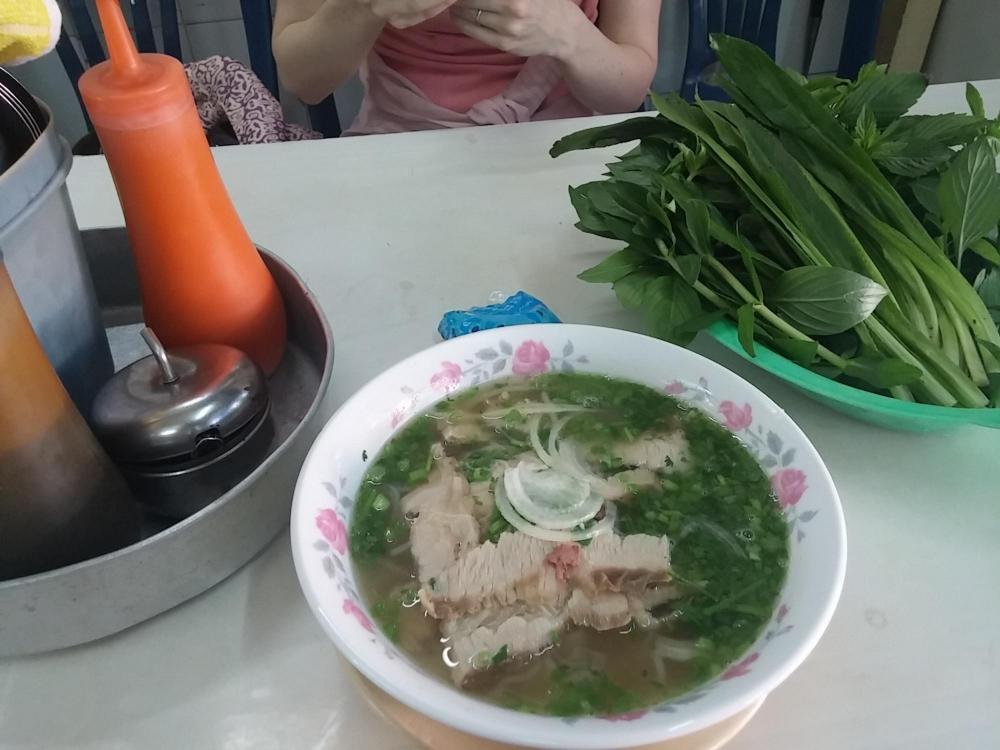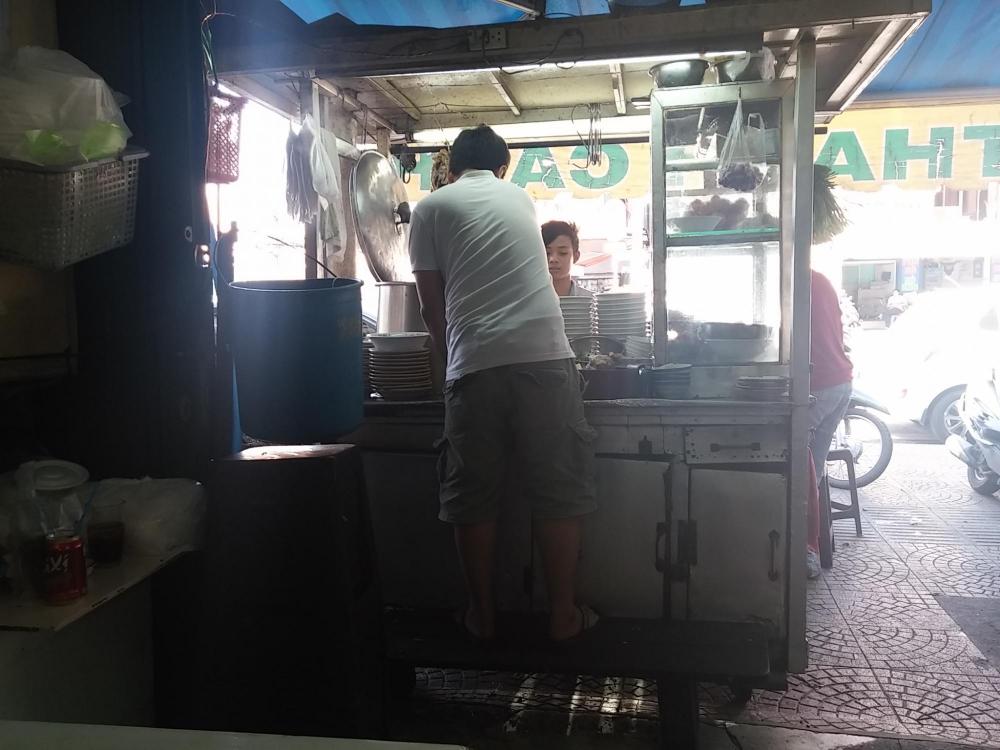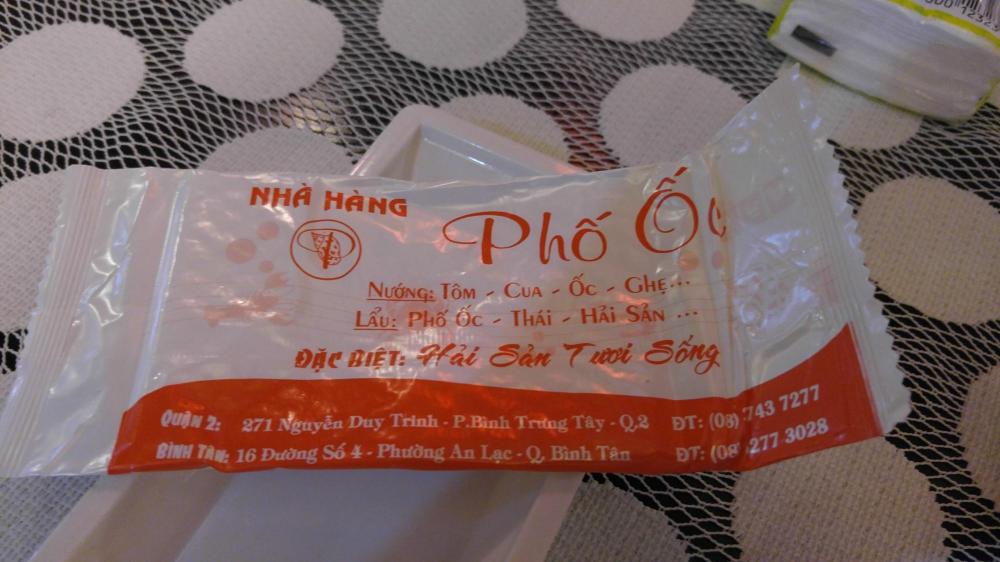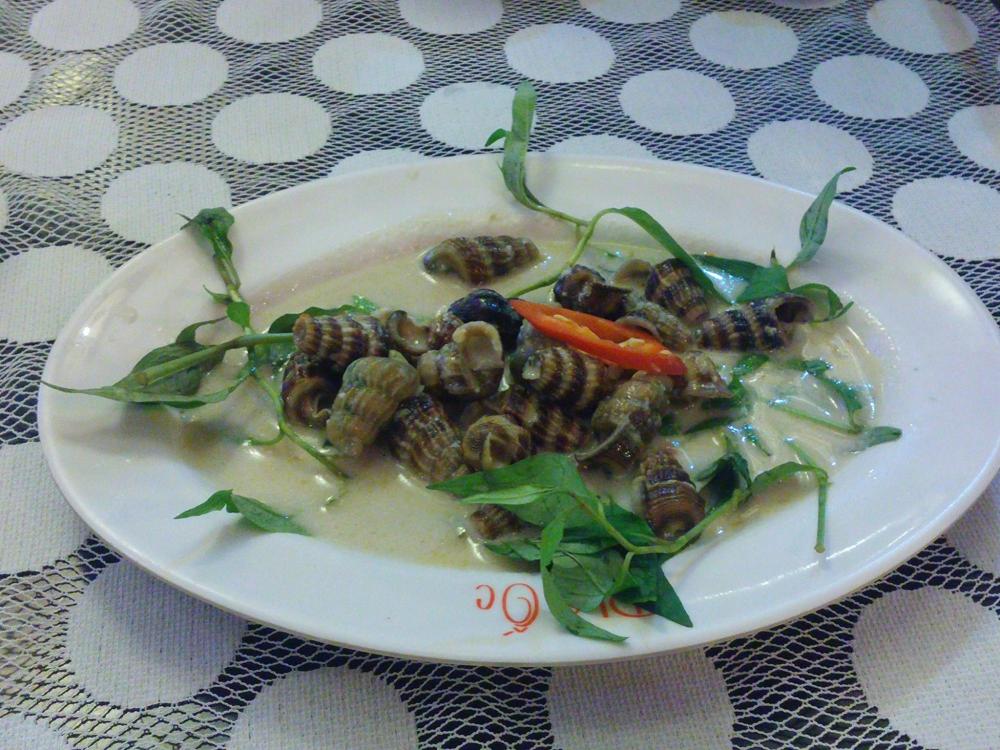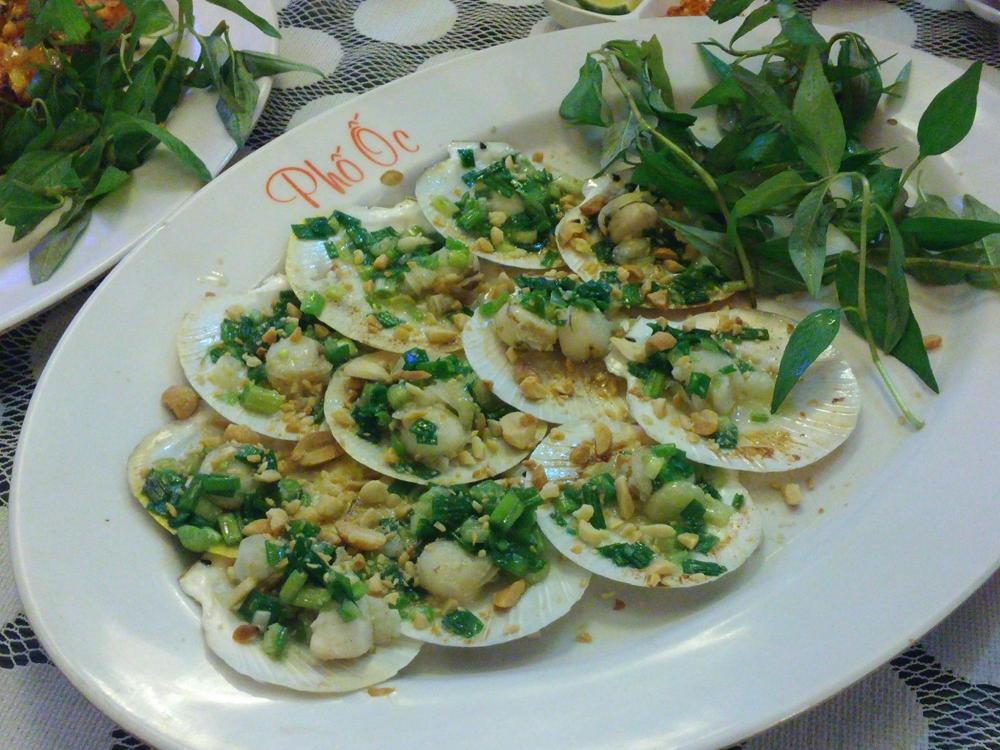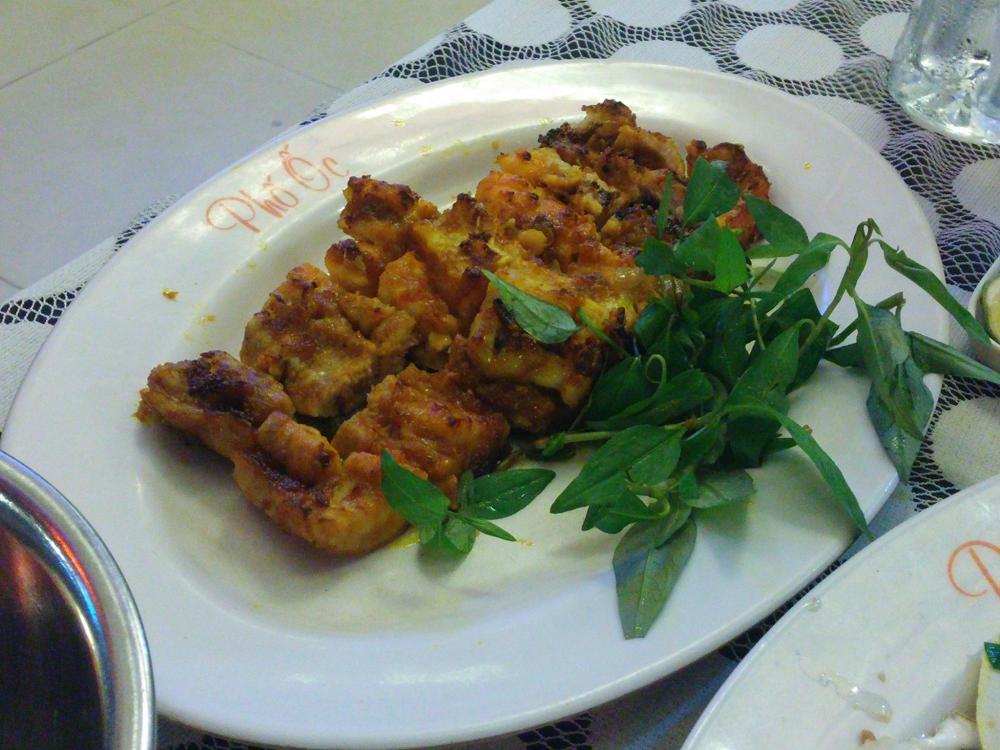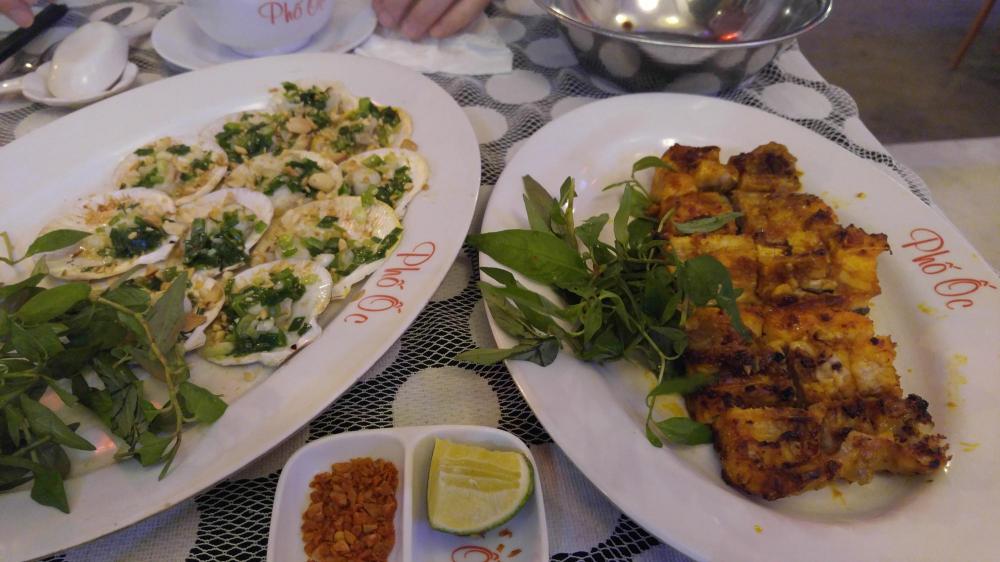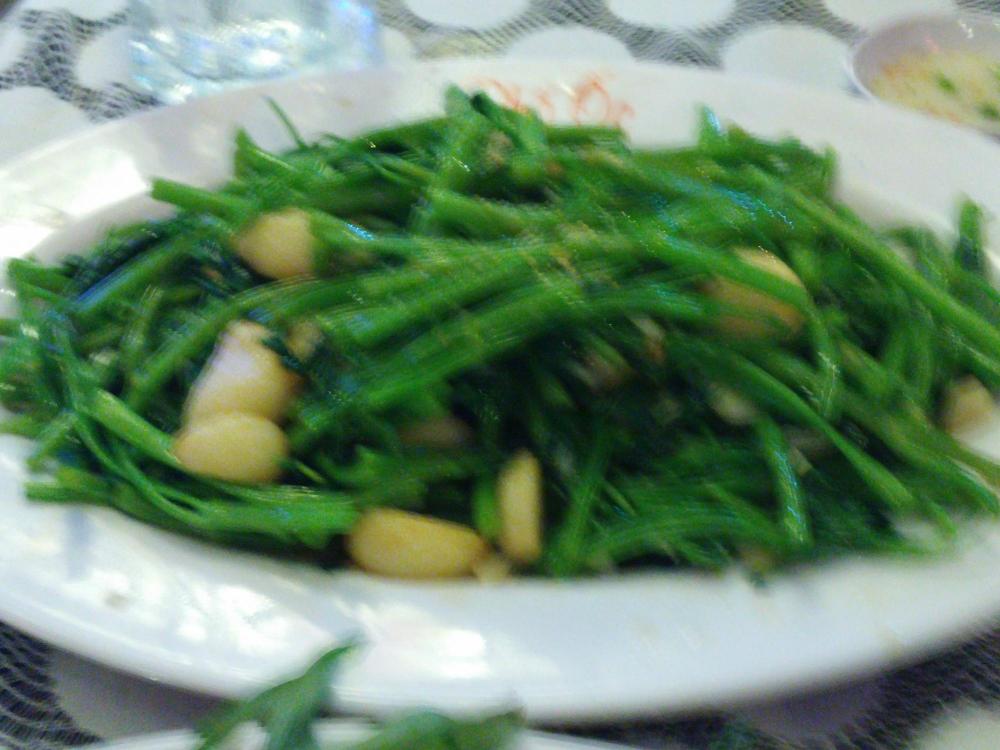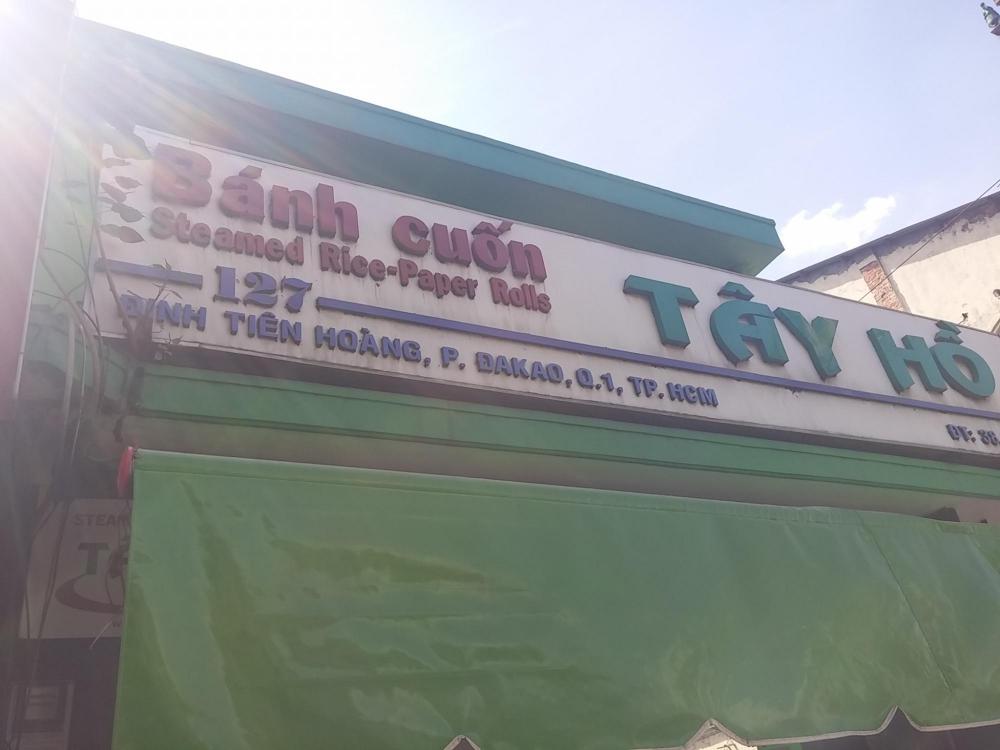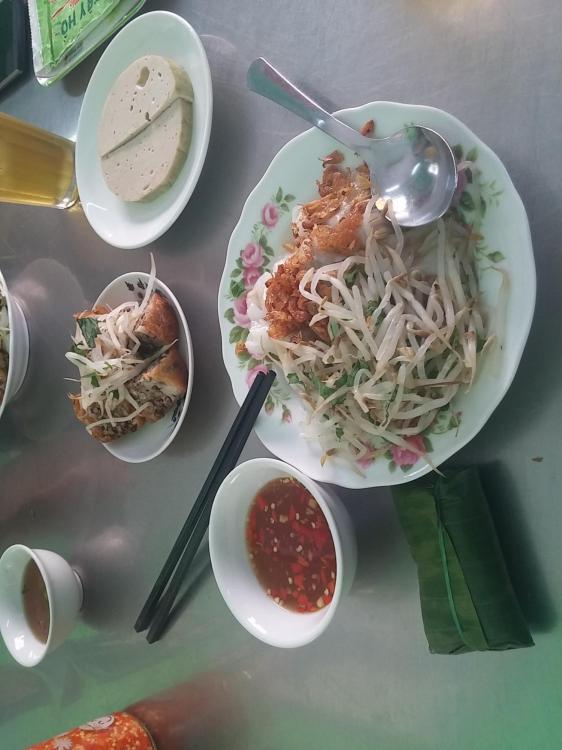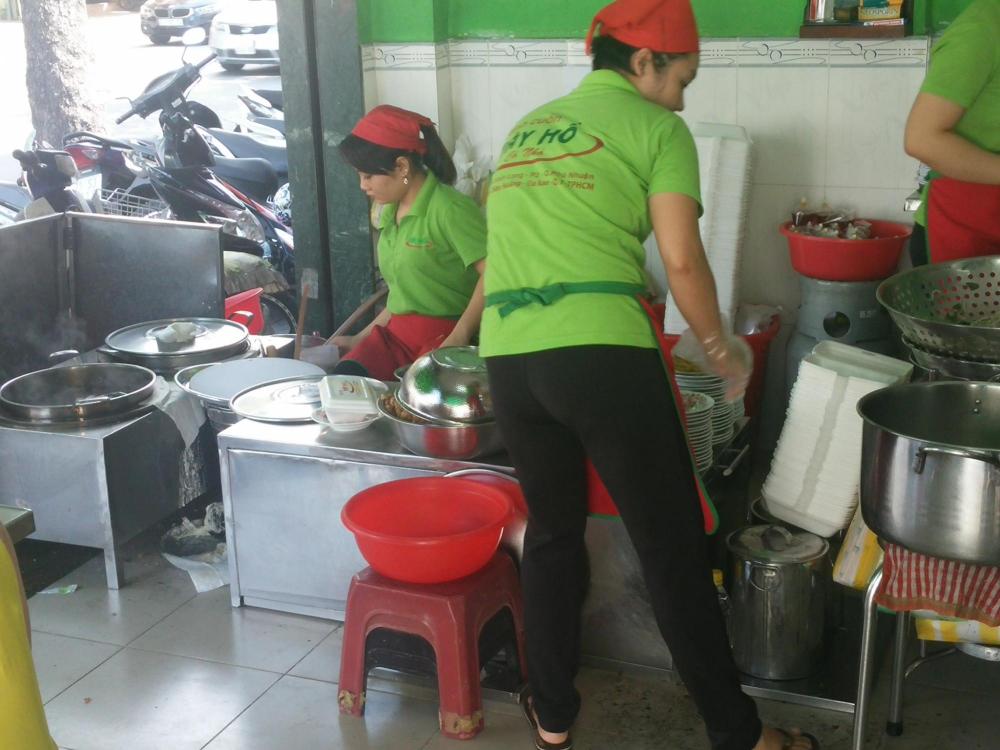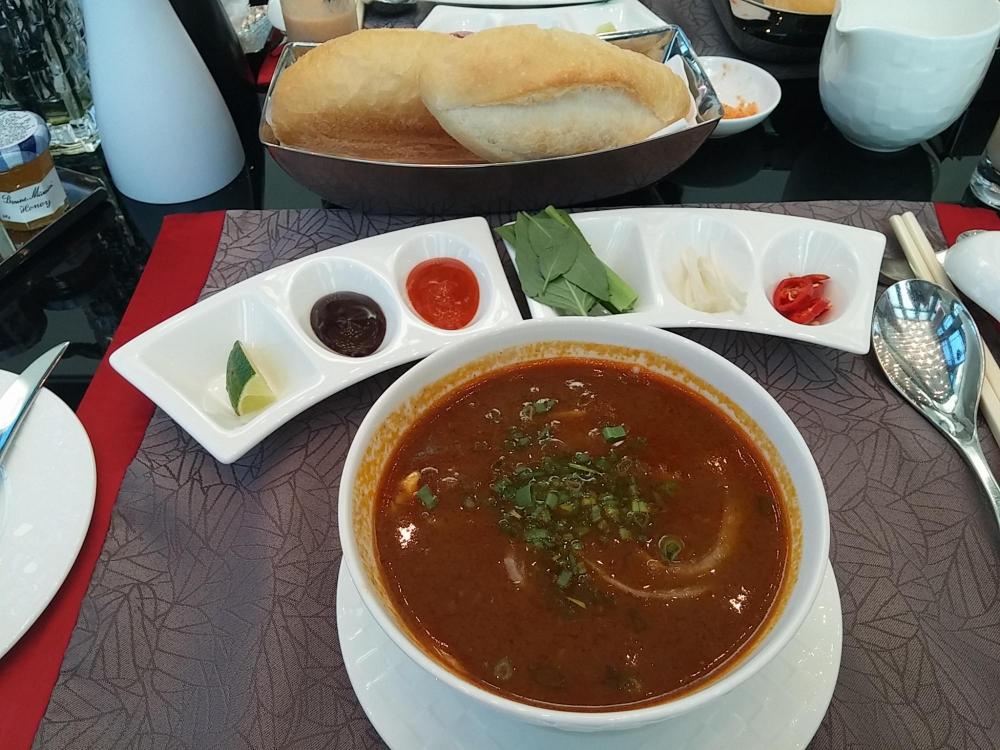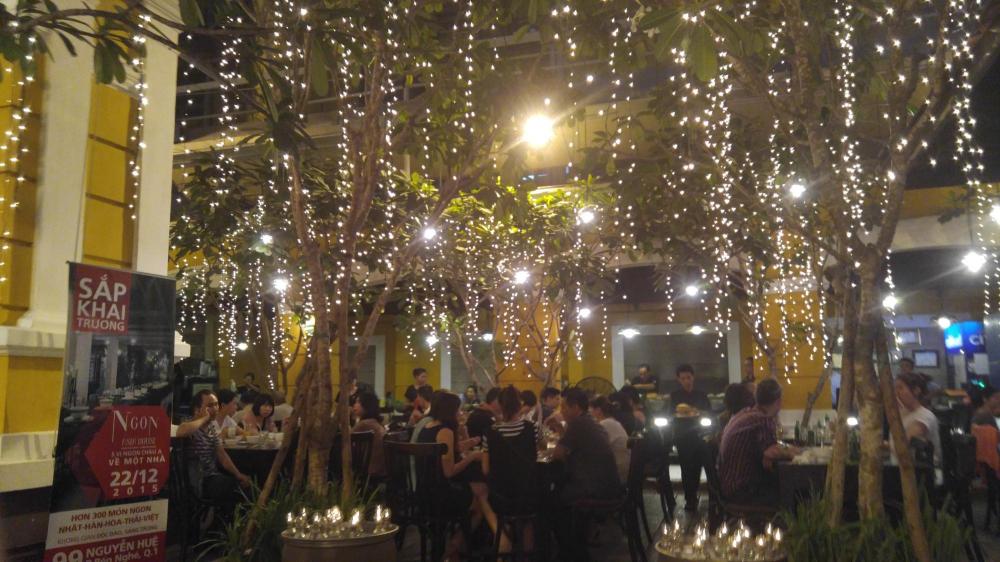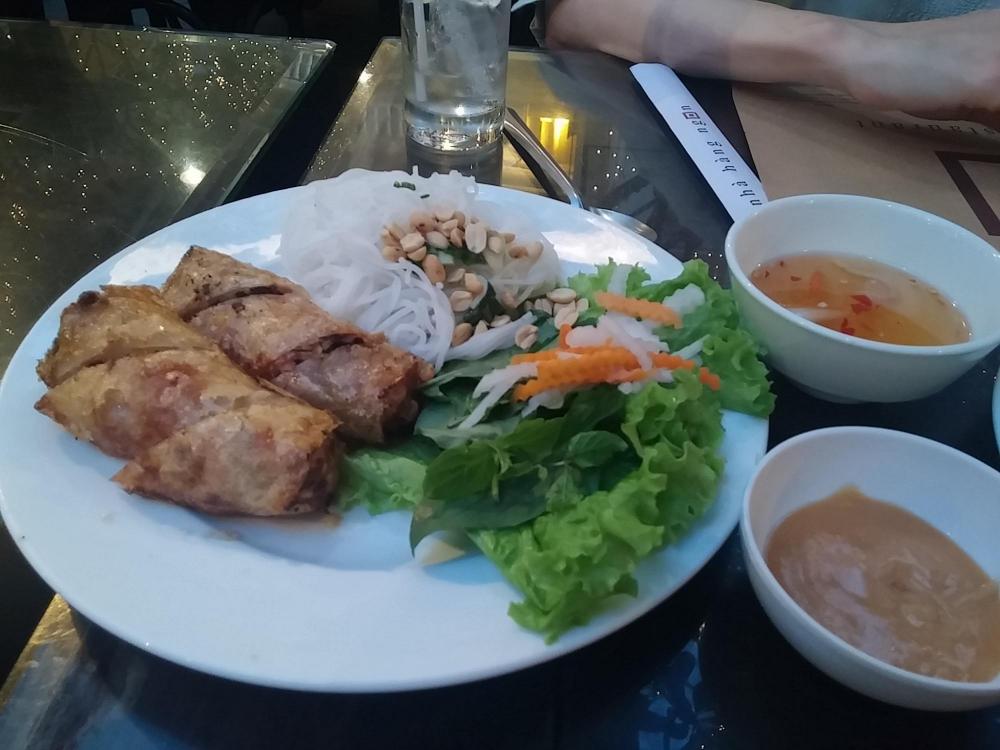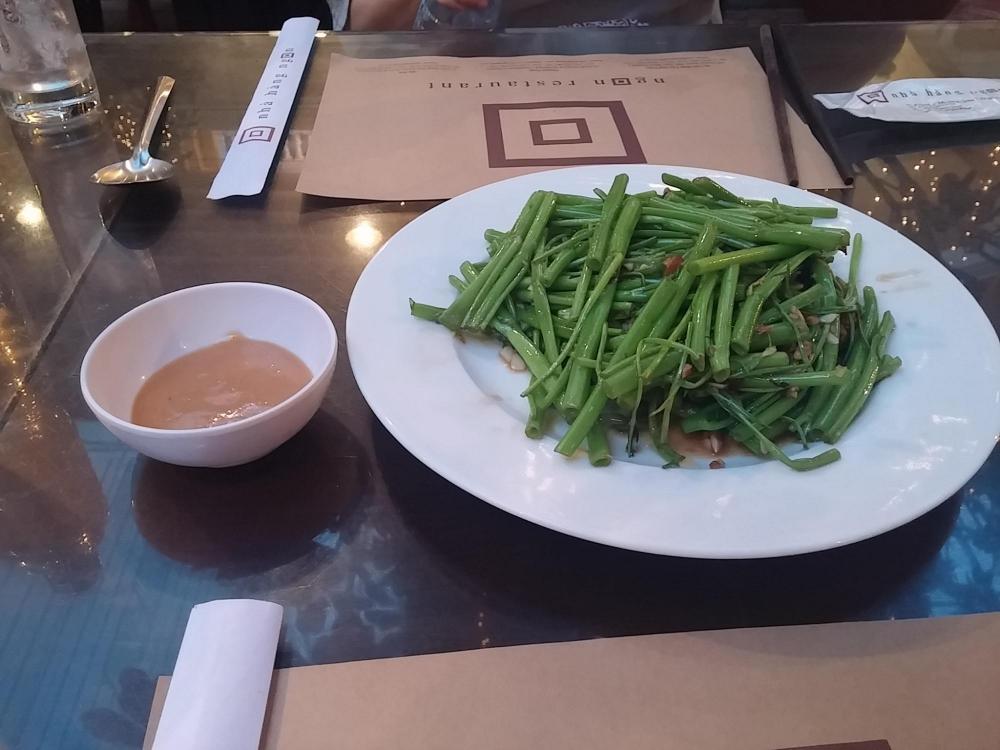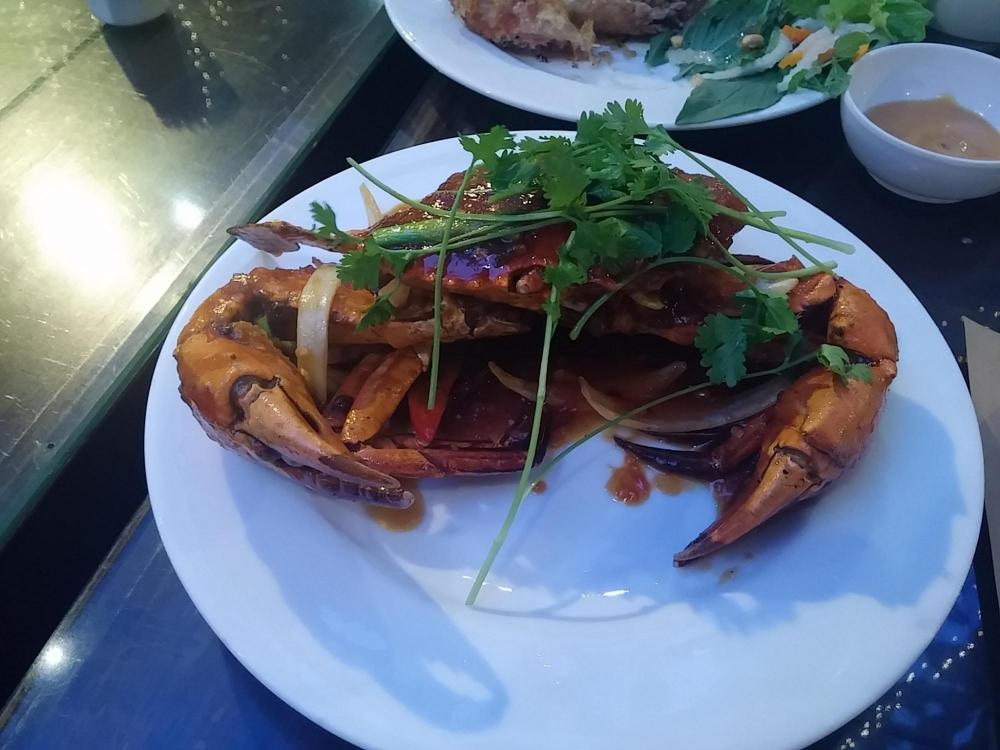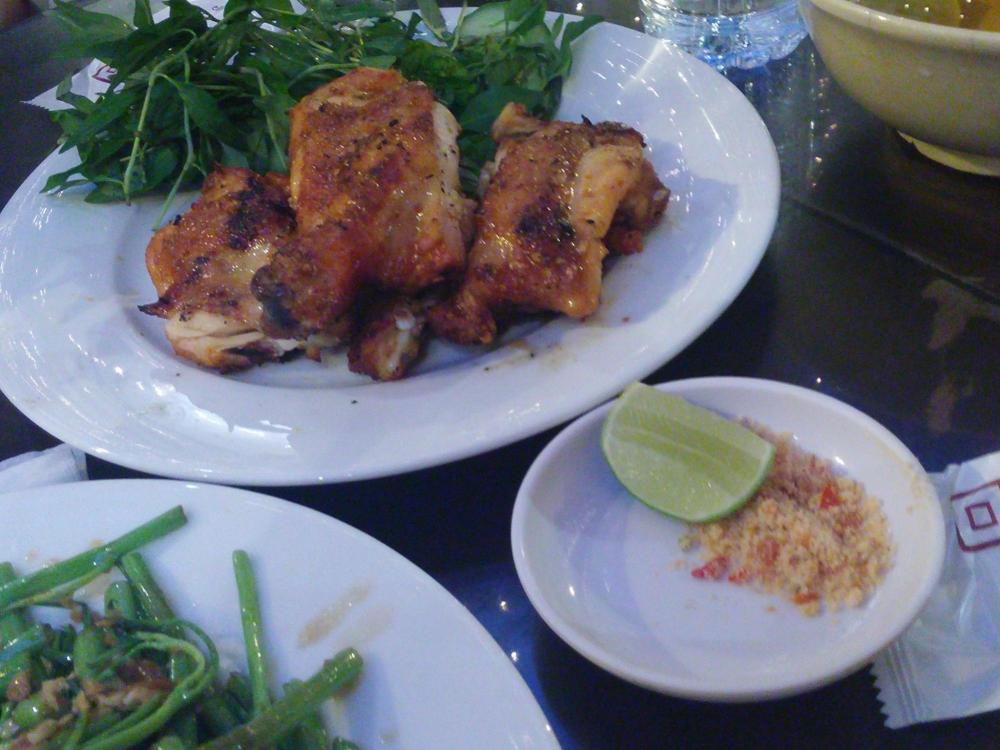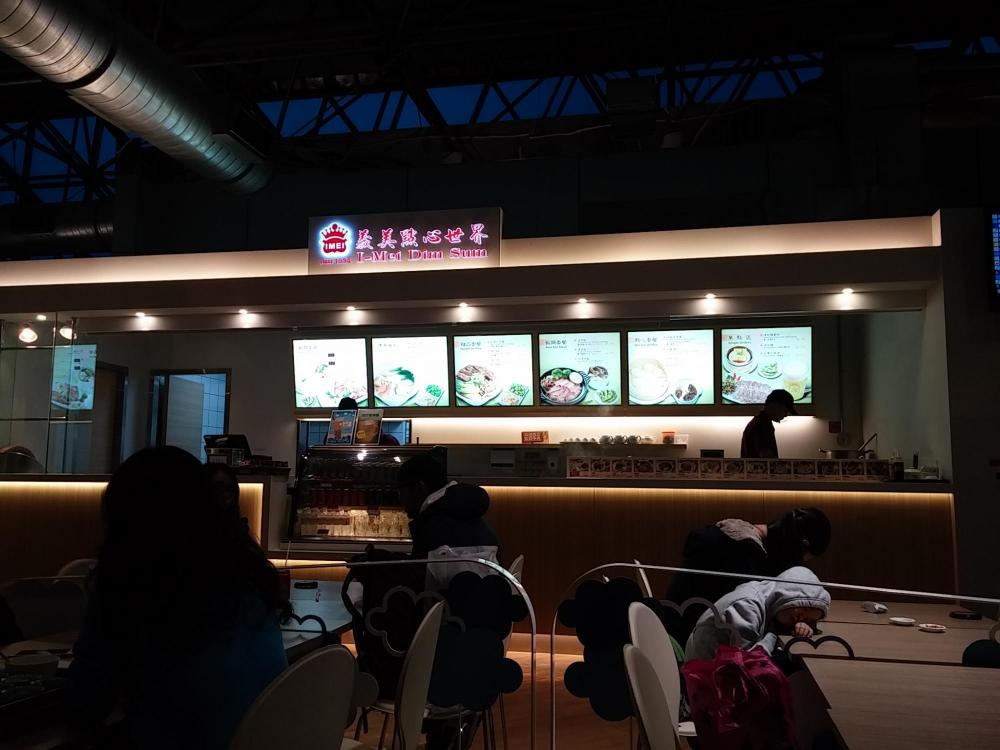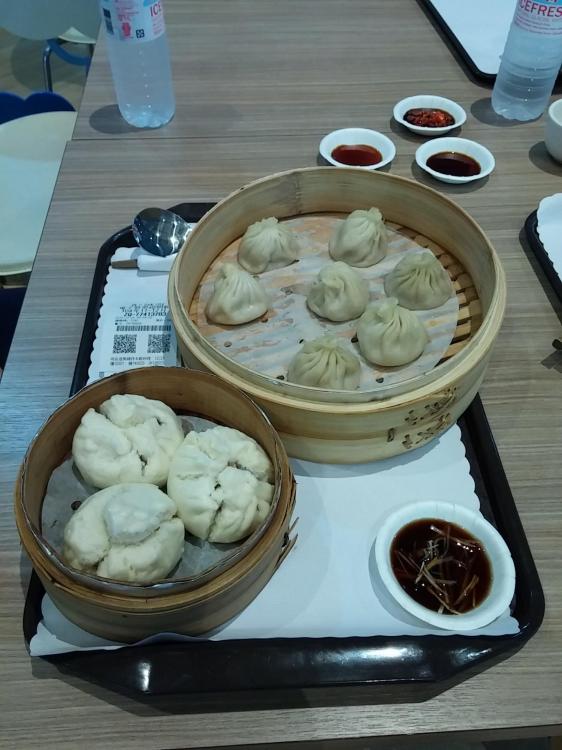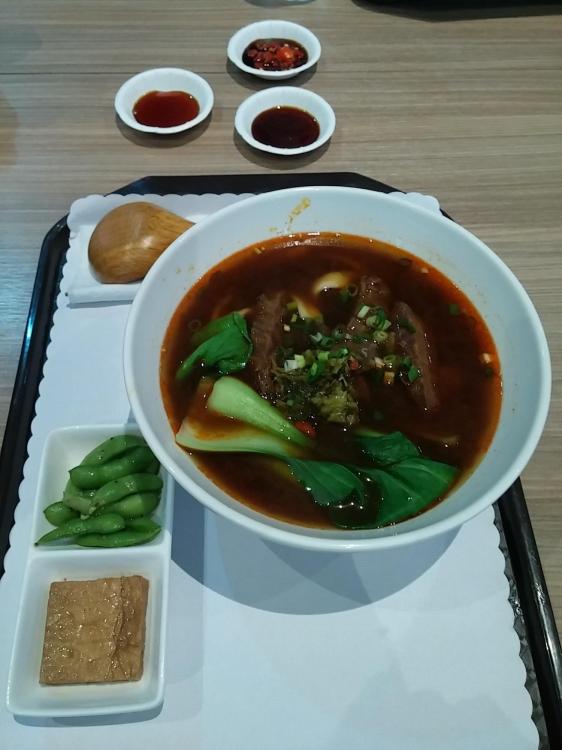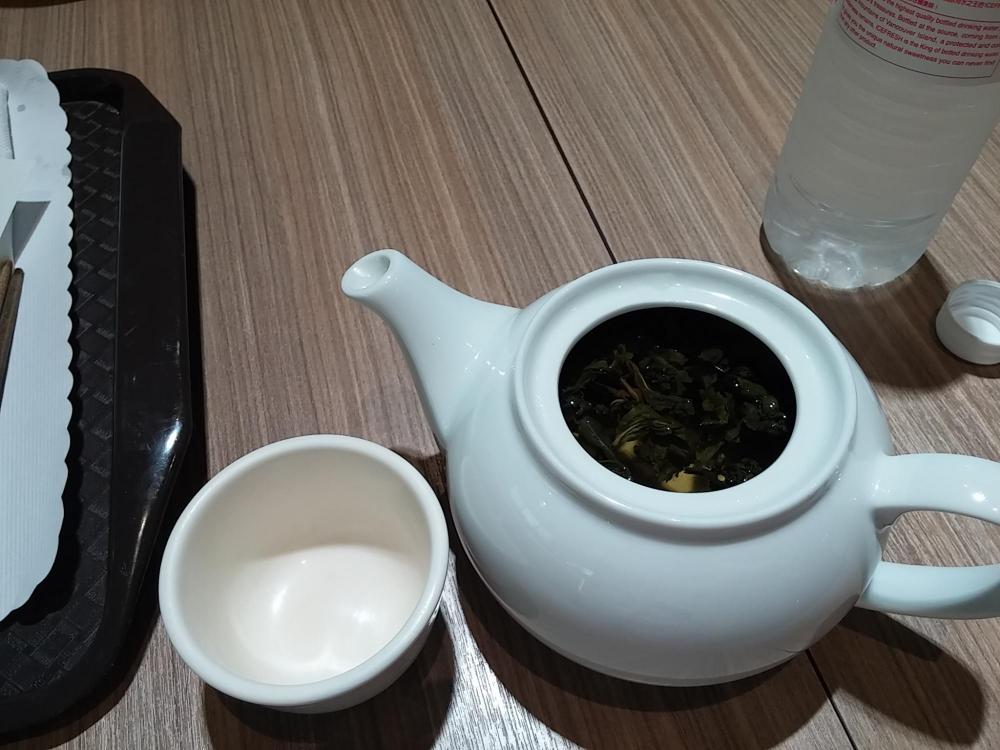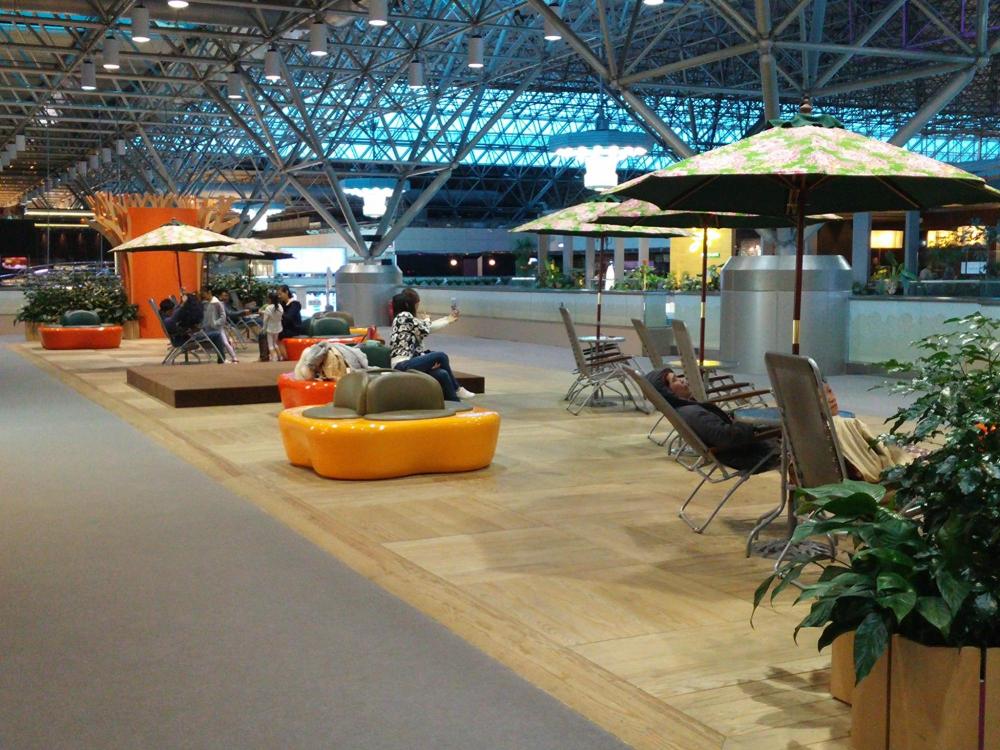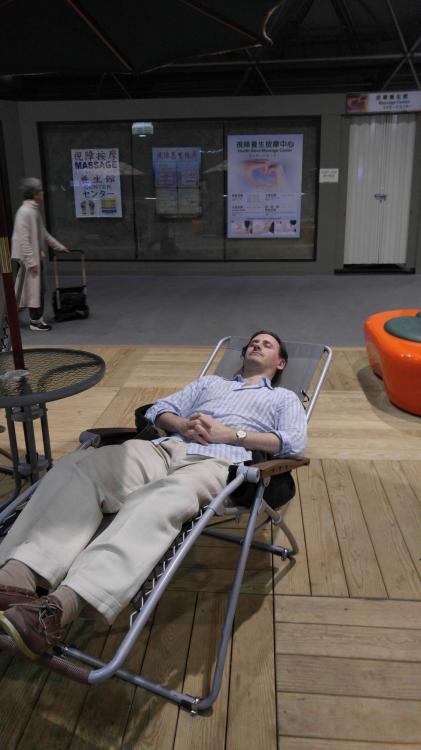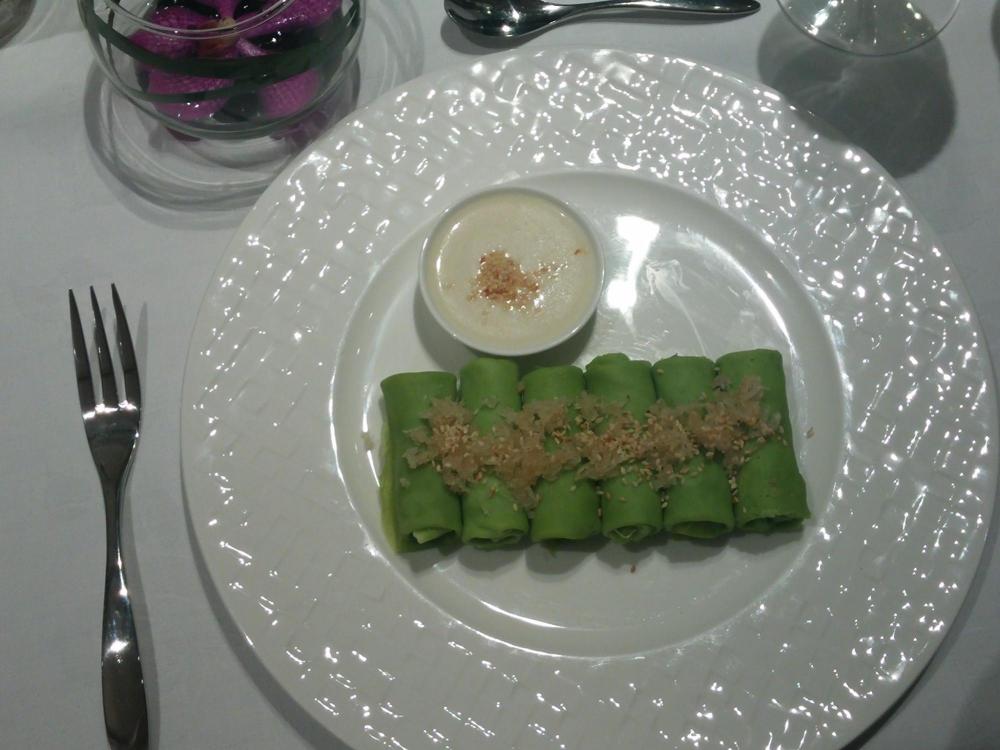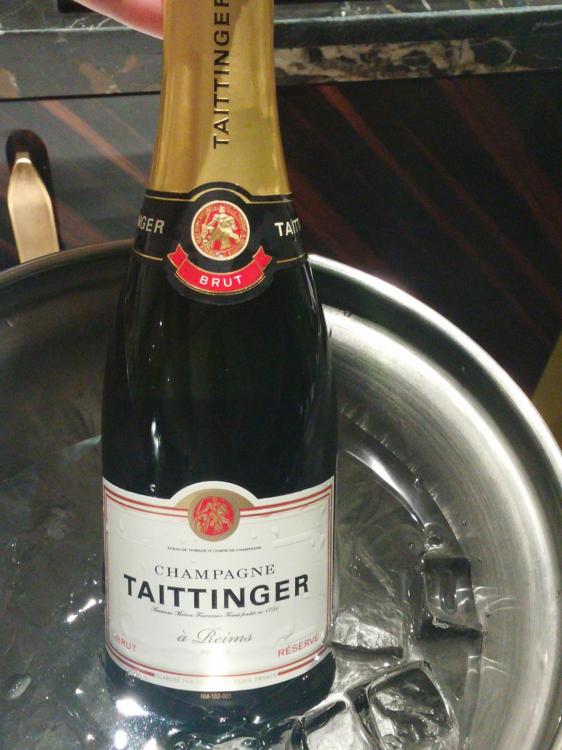
KennethT
participating member-
Posts
6,938 -
Joined
-
Last visited
Content Type
Profiles
Forums
Store
Help Articles
Everything posted by KennethT
-
I've never seen it at all in Chinatown in Manhattan - which doesn't mean I haven't just not noticed it.... come to think of it, I may have seen it as you describe at Kalustyan's... for something like $5 for 12 leaves....
-
It was really good... very tender... and the sauce was just made for dipping that banh mi!!
-
For dinner, we decided to try another Oc' place and went to Quan Oc Dao, a huge, and very well known seafood place located down a labyrinth of back alleys. They seated us at what looked like the last remaining table, located on the outskirts of the main area, so we had this vantage point: What you don't see is that since our table is located where it is, all the motorbikes and cars (why are there so many SUVs here?) who want to get to the parking lot go right past our table... like 2 feet away close... and it was a tight squeeze - one time, a car was trying to squeeze past while two motorbikes were trying to leave and inadvertently knocked over a whole set of baskets of snails all over the floor... needless to say a lot of yelling ensued, snails were picked up, and then quickly forgotten like nothing happened. This is literally right next to us - no zoom required: Again, no one spoke any English here (I'm sensing a theme) and their menu was wide, varied, and had no pictures, unlike some others... but, one of the blogs I was reading had a very helpful photo where they broke down a typical Oc' menu and explained what different terms meant to help in the ordering process. Once we ordered, they set our table. The ordering process is interesting. When you sit down, they provide you with glasses with ice, some dishes of sauces (here, a slight variant on the salt/chili/lime standard - their salt had a lot of black pepper and some chili), some herbs, and a plate of banh mi (bread). Similar to what we've seen in places in Singapore, there are women walking around in tight outfits provided by various beer companies. Each walks amongst the tables and tries to get you to buy your drinks from them, rather from their competitors. I think Sapporo dominated this place, but we also saw a Budweiser girl - although she was having problems getting customers. Once you agree on a beer, she brings it and pours it for you in the already provided glass of ice. She will then continue to refresh your ice as the evening progresses and try to sell you more beer. She tells your waiter the total count so it can be added to your bill. Separately, other women walk through the tables selling other foods that pair well with the seafood. They sell green mango with a chili/salt dip, quail eggs, and various other things... you must pay for these at the time of purchase - they are not added to your bill. We got some green mango (in the plastic bag): More rau muontg (topped with fried garlic) - excellent - perfectly cooked Snails in a tamarind sauce... the sauce was really tasty, and the snails were a little chewy, which helped you taste the sauce a little longer. Squid in a butter sauce. I had thought I had ordered more, including some shrimp and more of those scallops, but they never came - and by the time I was thinking about askinig about them, we were actually pretty full.... on leaving, I was able to take a nice action shot of grilling some shrimp - made me wish I had asked about them, but we made up for it later in the trip....
-
Just to cap off the detour... I am well acquainted with Well Sweep herb farm, and a few years ago, spent quite a bit of time with Sy, the guy who started it all... he's really fascinating, but I haven't been there in a couple of years... It's not surprising that they would have it. When I spent time there, I was also fascinated by all of the scented geraniums - I also picked up a bunch of flavored mints - like chocolate mint... and different basils.... and thymes.... so many different herbs, not enough space....
-
I'd also recommend downloading Sous Vide Dash if you have an iOS product (iPad or iPhone). The last time I checked, it was $10, and worth every penny. It is a huge help to make sure you are cooking things safely, and is really good if you like to do gradient cooking. I do this with salmon - I prefer my salmon with a bit of a gradient, so I set my bath to 115F, but shoot for a core temp of 102F - then sear with the propane torch. This makes the salmon perfectly rare throughout most of it, and just a bit more done on the outside edge for a bit more bite. It also significantly decreases the cooking time.
-
One place where every tourist goes is the Ben Thanh market... here's a shot at night: This place is huge and VERY crowded. They sell everything from fruits, veggies and meat, to flip flops, t-shirts and plastic toys... There is also an area of the market with restaurant type stalls.... In the past, we have been places with aggressive hawkers - I can think of one street in Brussels which is one small restaurant after another, each with a guy hawking you in 4 different languages to come in as you walk by.... that's nothing compared to this. People basically shoving things in your face (not an exaggeration) for you to inspect and buy, and others grabbing you by the elbow to walk you to their restaurant. Absolutely insane.... I couldn't get a picture of anything too aggressive (I was too busy trying to fend them off) but did get a few pics of fruit and veggies:
-
Thanks for this! I haven't spent much time in the chinatown groceries in Queens or Brooklyn, but I have not seen this anywhere in stores in manhattan... I was thinking about trying to smuggle in a few branches of various herbs we came across and clone them, but decided that I didn't want to take the risk at customs... in retrospect, we would have been fine... I have had pretty good luck in cloning plants - although part of that luck is really because of rooting hormone gel, and special root stimulating plant food....
-
The next day, for lunch, we had our first true bowl of southern style Pho Bo... (keep in mind that since I'm not using the accents, the word 'pho' in 'pho bo' is actually different from the word you see in the post above 'pho oc') We had a great recommendation to go to this place: Again, the photo came out rotated for some reason.... anyway, I had a bit of a language issue where the server asked me something and I didn't quite understand, but just said yes... I'm always nervous to use my newly acquired language skills in the beginning of the trip, but wind up getting comfortable with it by the end. My usual order is Pho Tai Nam, which is beef broth with the raw beef and the well done brisket. My wife typically just gets the Pho Tai which is the rare beef. In any case, what we wound up with was 2 bowls of Pho Nam: This was incredible... the broth was beefy and flavorful, the brisket was ridiculously tender... and note the herb basket on the side - this is typical in the local places - a mountain of herbs - I think there were at least 4 different kinds in that basket... there was saw tooth, thai basil, rau ram, and some other kind of mint.... I don't remember if this assortment had the diep ca in it... this is an interesting herb - diep ca means 'fish mint' and it has a distinctly fishy taste... a little odd... but works well in combination with other ones... Here's a shot of the cook hard at work: What we didn't take a photo of (we thought it would be rude) was that the old guy who seemed to be the owner, had a lounge style lawn chair set up basically in the middle of where the tables were, and he was taking a nap. The funny thing was, it seems like this is the Saigonese past-time... napping in public places in seemingly uncomfortable postions... This guy was passed out lying on a few motorbikes.... and:
-
For dinner, we decided to do what seems like a local favorite - snails and seafood! I had read a recommendation about this place in District 2, which was about a 40 minute taxi ride from our hotel: Unfortunately, I neglected to take a picture of the outside/signage, but my wife did take a picture of their moist towelette which had their name and info. We really enjoyed this place. None of the staff spoke English, but they really did try to make it a good experience for us - even by miming how to eat some of the things we ordered when it was not so obvious. These are snails in a mild green coconut curry sauce. The texture of these were really interesting - half of the snail was a little chewy, but the other half had this great creamy texture. The herb in this picture is the ubiquitous rau ram (vietnamese coriander). I don't know why people link it to coriander, since I don't think it tastes anything like it. To me, it had a lemony, citrusy flavor, and I loved it - out of the maybe 10 different herbs we had over the week, I think this one is my favorite. Since I have never seen it in New York, I will most definitely try to grow it in the future. This was the first experience of us not knowing how to eat these things. I must have sat there for a few minutes trying to figure out how to get the snail out of the shell with the little fork (which was basically a normal 4 tine fork with the outer 2 tines cut off!) The waitress, seeing me struggle, came over and mimed that you're supposed to suck these guys out of their shell! Here's my wife, demonstrating: We also had these: Bay scallops grilled with green onion and peanuts. These were incredible... the best scallops we have ever had - and includes the previous number one slot, the scallops at Sin Huat Eating House in Singapore. I have the feeling that they add pork fat to the scallop while they're being grilled... note more of the rau ram on the plate. It's a great herb to eat with seafood - it does a good job of cleaning the palate to get ready for the next bite. This is some kind of fish (sorry I don't have more detail) that was rubbed with chili and salt and I don't know what else, then grilled. It was served with the very common sauce of the dish of chili salt and a lime. I initially started to dip the fish into the chili salt when the waitress stopped me and showed me to squeeze the lime into the chili salt to make a saucy paste, then dip the fish into that.... much better!!! The texture of this chili salt was interesting - the salt looked like pop rocks... I have no idea how they got that kind of texture with it.... this shot below shows the scallops and fish together, with the chili salt (pre mix): And of course, I couldn't help but to get more rau muong (morning glory stir fried with garlic) - sorry it came out blurry, but it was perfectly cooked with a lot of big, sweet garlic cloves: The cost for this meal, including a couple bottles of water was about $10-12.... by the way, the 40 minute taxi ride cost about $8! Totally worth it, and it allowed us to see a district that is basically just a residential area...
-
Alright... now we get to the good stuff! For lunch, we went to: Banh cuon is typically a northern specialty, but this place has been a local Saigon favorite for many years. An interesting side note, most of the taxi drivers do not speak English - but I found that a good way to communicate (other than with my horrible butchering of the vietnamese language) is to put the address into google maps on your cellphone and show them. Not only does google show the address with the appropriate accents, in some cases, it will show what is located at that address - so, when the driver sees you going to a local favorite, it was not uncommon to get a big smile and a thumbs up! So, here it is, in all its glory: OK, this photo displayed rotated counter-clockwise by 90degrees... so just turn your head to the left... Banh cuon are rice rolls - a batter is ladeled onto a fine screen above a steamer and steamed until set which takes about 30 seconds. The cook then transfers it to a metal surface where another worker cuts it into 4-5 pieces, puts in a small amount of pork and mushroom filling, rolls them up, and stuffs them in the bowl with a ton of steamed bean sprouts mixed with herbs and tops with fried shallots. On the table, there is a pitcher of a slightly sweet fish sauce which you pour into a small dish and add as much chili as you'd like. You then have options on how to eat it... some people would take the spoon and use it to drench their banh cuon with the sauce in the bowl... others would dip bite by bite... I preferred the drench method... we also got (poking out of the top right of the picture) some cha lua which is some kind of emulsified pork sausage, and a fermented pork sausage that was wrapped in the banana leaf. I really liked this sausage - it had a slightly sour taste and it was studded with bits of chili. Also, we got a plate of their deep fried mung bean cakes. This dish was incredible... a real flavor bomb from the sauce and herbs, the texture of the rice roll, and the savoriness of the pork and mushroom filling... and, this whole feast (including another portion of the banh cuon and 2 tra da (iced tea)) was about 90,000VND, or about US$4, at 22,500 VND per dollar. This place was so good, we actually went back there for lunch on our last day. Here's one last shot of them making it - the kitchen area is right out by the street - right by the entrance, which was the most common location...
-
We woke up the next morning refreshed and ready to start our adventure... one other thing that we have learned is that the best way to start the trip off right is to get a great first night's sleep... what this means is that we finish dinner around 6PM or so, get back to the hotel, take 2 benedryl, and go to sleep. Even though we are already exhausted, we take the benedryl to ensure that we will stay sleeping and not wake up at 3AM wide awake. So, for instance, on this trip, we woke up about 12 hours later - around 6AM, basically now on Saigon time for the rest of the trip. There are pluses and minuses to having breakfast included in your hotel rate. The good thing, obviously, is that you don't have to pay for another meal, or the translation is that you don't have to pay hotel prices for being able to eat first thing in the morning without going outside. There's nothing worse that being starving and having to wander around for who knows how long trying to find something good in a strange city. So, that being said, here's our hotel breakfast: This is a very lackluster (but fancifully presented) bowl of Bun Bo Hue. Note the pitiful lack of herbs (sorry to keep making you wait to see the real thing). The broth was also quite weak and had little flavor. This is Bo Kho - a beef stew that uses bread (banh mi) to dip into the sauce. The meat was beef shin, more commonly known in the west as osso bucco. This was the best vietnamese option on the hotel menu, so we had it practically every day. The best part about it was the banh mi - the texture of the bread in this city is amazing... the outside is so crisp, it shatters, while the inside is light, airy and tender. The only thing that I have ever had in the US that is even close to it is Po Boy bread in New Orleans. Also, note the very small amount of herbs present - here you see thai basil and saw tooth herb.
-
Oh, and by the way, none of the vietnamese words I am going to use in this blog have the required accent marks.. I just don't have the patience right now to figure out how to do it. If you're curious to see how it's spelled, put the names into google, and you should see results with it spelled properly. Also, note that many words are not pronounced the way they look... plus, pronunciation varies from North to South Vietnam... For instance, in the south, Chả giò is pronounced Tsha (with 'questioning' falling then rising tone) Yo (low falling tone).
-
If there's one thing we've learned from taking a few trips 12 time zones away, it's that, no matter what, by late afternoon on the first day, we will be exhausted and ready for bed! So, now, in advance, I try to find a place to go for dinner that is within close walking distance from our hotel, won't take too long, and doesn't have to be super-fantastic since we'll probably be too tired to really enjoy it thoroughly anyway. Fitting this bill nicely was Nha Hang Ngon, an EXTREMELY popular tourist restaurant. This place is busy morning, noon and night. They're known for taking "the best of Saigon's street food" and bringing it indoors in a safe, tourist friendly environment - which basically means there are menus with English, wait staff who speak English, and things come on relatively fancy plates and silverware. We have found that this also means that the flavors are most definitely muted, and despite being significantly more expensive, the preparation quality is not nearly as good as the true local food that it is meant to reflect. As you can see below, it's a very pretty restaurant - they have an outdoor courtyard, and also indoor seating in their beautiful French colonial building. Here's what we had: Cha Gio - spring rolls. There are a few things to notice here that will differentiate this restaurant's version from others we experienced in local places later on: A) served with a peanut sauce (lackluster at that) - spring rolls are typically not served with a peanut sauce - peanut sauce is served with the summer roll (goi cuon) B) these spring rolls are greasy and C) there is a ridiculously paltry amount of lettuce and herbs. Rau Muong - stir fried morning glory... a very good version Crab with tamarind sauce. What you can't tell from this photo is that the crab was overcooked... tamarind sauce flavor was nice though. Ga Nuong - grilled chicken served with chili salt. The chicken was tasty - but despite their fluancy with English, the staff did not tell us what to do with the chili salt - we actually found out the next night at a local restaurant where no one spoke any english whatsoever - but we got a lot more information from their extremely helpful staff from their miming/pointing and my horrible Vietnamese which I had been learning for the past month. It came in handy in quite a few occasions... but that's to come... Anyway, back to the chicken... without direction, we assumed that you're supposed to squeeze the lime onto the chicken, then dip the pieces into the chili salt... turns out, the intention is to squeeze the lime into the chili salt to make a sauce, and dip into that.
-
OK - so we're home, and I'm currently in the process of downloading all the photos from the collection of cameras and phones... while that's going on, I can give a bit of a preface to the upcoming trip. As some of you may know by now, I am a bit obsessed with the food and cultures of SE Asia... I'm not sure why... 10 years ago, I had decided that I wanted to go to SE Asia for our honeymoon (neither of us had ever been before) and even planned our wedding date around a good time to go there, weather-wise... At the time, I thought it would be a trip of a lifetime and that we'd never make it back - mostly because it is so far away with a flying time of about 20 hours, and 12 hour time change... Little did I realize that the flight is really not that bad - I actually prefer those flights to flights to CA or Europe since you have enough time to medicate yourself and actually get a decent amount of sleep on the flight. Also, the seats in coach are definitely comfortable (I'm looking at you Singapore Airlines, Cathay Pacific and EVA) the food is decent, and the jetlag is not as bad as I thought it would be. So, now, I try to go there at least once every couple of years, if not every year. This year, we realized a few months ago that we had enough time to take a trip during the week between Xmas and New Years... I had always wanted to go to Saigon, but hadn't in the past since our typical summertime vacation is a horrible time to go there, weather-wise. It is the height of their rainy season, which, with an average rainfall of 12-14 inches of rain per month at that time, practically guarantees getting stuck in some heavy downpours, if not some major flooding. So, with the opportunity to travel during their dry season, we jumped at the chance - which worked out since we did not see a drop of precipitation (or a cloudy day for that matter) once during our 7 days on the ground. There is a bit of an issue with planning when it comes to Vietnam, as opposed to some other countries in SE Asia - there is just not nearly as much information available. Sure there are guidebooks, but as I've found on other trips, the best food is definitely not found in a guidebook! I did find a few blogs written by expats living in Saigon that provided me with more than enough information though. For anyone planning on traveling to Saigon or Hanoi, or just interested in a good read about the street food scene there, I would highly recommend reading Graham Holliday's book, "Eating Viet Nam, Dispatches from a Blue Plastic Table". It's a bit dated, and a few of the specific places he mentions are either impossible to find, or don't exist anymore, but it really sets the scene very well. I also enjoyed reading and got lots of info from the following blogs: LegalNomads.com, EatingSaigon.com, and VietnamCoracle.com Enough background... our trip began on the 24th of December, with a 12:20AM flight from NYC to Taipei on EVA Airlines. We've taken this flight before since I find EVA to have some of the best prices, compared to Cathay Pacific, and I like the very late (or early) flights since I can work a full day, go home, leisurely pack and have dinner, then go to the airport with no traffic. Then, once on the plane, I can medicate myself and sleep for a good 6-8 hours after being fed a decent meal, then watch a few movies on the video on demand system, be fed again (not counting the numerous snacks available in between) and land. Since we've gone this route a few times, we have found our favorite place to eat while in the Taipei airport: I-Mei Dim Sum! Sure, it's not the best dim sum around, but for airport food, it is stellar. We had the Xie Long Bao (pork soup dumplings), Char Sieu Bao (fluffy buns stuffed with BBQ pork) and a Taiwanese beef noodle soup. The Char Sieu Bao is different from the versions we had all over Hong Kong - less sweet and much more savory, with a slight smoky flavor to the filling. The beef noodle soup has a strong spice flavor of star anise. I also enjoy getting a nice Taiwanese loose leaf oolong tea: One last thing to note about the Taipei airport is that the EVA flight lands at 5:15AM, but the restaurant doesn't open until 6, which leaves you some time to find this: A nice "beachy" lounge (for free) where the lounge chairs recline back so far that your feet can be actually higher than your head! I enjoyed a nice nap here while we were waiting: Next stop, Saigon!!!!
-
Happy New Year! I'm sitting at the gate waiting for my flight from Saigon to NYC connecting through Taipei so I figured this would be a good opportunity to get started... But this is just the intro- the rest will gave to wait until I land about 22 hours from now, sleep for about 12 hours, then get my photos in order! We had a great week enjoying beautiful weather, taking in the frenetic yet relaxed street life and eating some amazing local food... Our flight here was on EVA Airline and was very pleasant and uneventful. Our flight from Nyc to Taipei left around 12:20 AM on the 24th. I love those night flights since it makes it very easy to get a decent amount of sleep, even in coach. EVAs food is quite good eith both Chinese and western choices for dinner and breakfast, and they came through several times with snacks such as a fried chicken sandwich with some kind of mustard. I think I had 4 of them! Once I get home, I'll continue posting with pics from our feast in the Taipei airport.... Spoiler: those who have read my Singapore foodblog from July may see a slight trend...
-
If you'll be going to Saigon, and are planning to eat local food in non-tourist locations, then this blog will be great for you.... Stay tuned! Sorry to derail this thread a bit... Now back to our regularly scheduled programming...
-
We've been in Saigon for the past week!
-
Urgghhh... Now I remember why I dont try to write a longish post using my phone.... I lost it! Anyway, since we're traveling right now (leaving to go home tomorrow ) we're not cooking anything, but we had an awesome dinner of snails and seafood, pics to come when I do my foodblog after I collate all the photos... But in the meantime I'll post a few photos as we're back in our room awaiting the fireworks due in a couple hours... We ordered room service for dessert - pandan flavored banh cuon stuffed with shredded coconut with a cocolicious dipping sauce. Plus a little drinky-poo for after we do some packing... The ladt shot is the craziness in the street just below our hotel! And happy anniversary Shelby - what a great date... so easy to remember!
-
All the mangosteens I've seen in NYC are frozen or defrosted... And disgusting compared to the fresh ones.
-
I wouldn't suspect greenhouse mangosteen since the trees are notoriously hard to transplant. I became so fascinated with them a few years ago, I actually researched it. The trees take a long time to be mature enough to bear fruit (15-20 years!) and most dont survive past a few years after transplant. Since the importation of fresh mangosteens are prohibited in the US, a few companies tried to creat orchards inPuerto Rico but with no success. I wonder if they're being grown in Northern Australia? That may be a tropical climate and would be their summer now...
-
Does anyone know when mangosteen season is inSE Asia? I had always thought it was a pretty short season from late spring through mid summer.... I'm in Saigon at the moment and saw a vendor selling them out of a basket strapped to the back of a motorbike. But he was the only one I've seen with them all week.... I didn't get any... But I was curious if anyone knew any more info... Tomorrow's another day!
-
Yes unfortunately the sv dash is ios only. However nathanm's tables require no operating system. I'd figure the timing for you but I'm on vacation and dont have access to sv dash or the tables which i printed years ago and searching for the tables on my phone seems less than pleasant. I'm sure if you wait a few hours for people to wake up someone can help you more specifically than I.
-
As I'm sure you're aware, sv times are dependent on thickness, bath temp and core temp. Using a bath that is just over your core temp will result in the even cooking that most love sv for, but will take the longest time. To specifically answer your question, I'd advise using either Sous Vide Dash (a VERY useful app if you do lots of sv cooking) or you can use the charts provided by nathanm many years ago in the original sous vide thread. However, part of me wants to know why you'd bother cooking the pork roast well donev SV... Wouldn't it be easier and faster to roast conventionally?
-
Very interesting. Are the recipes from a specific region, or do they roam around China as a whole?
-
Hilarious....


